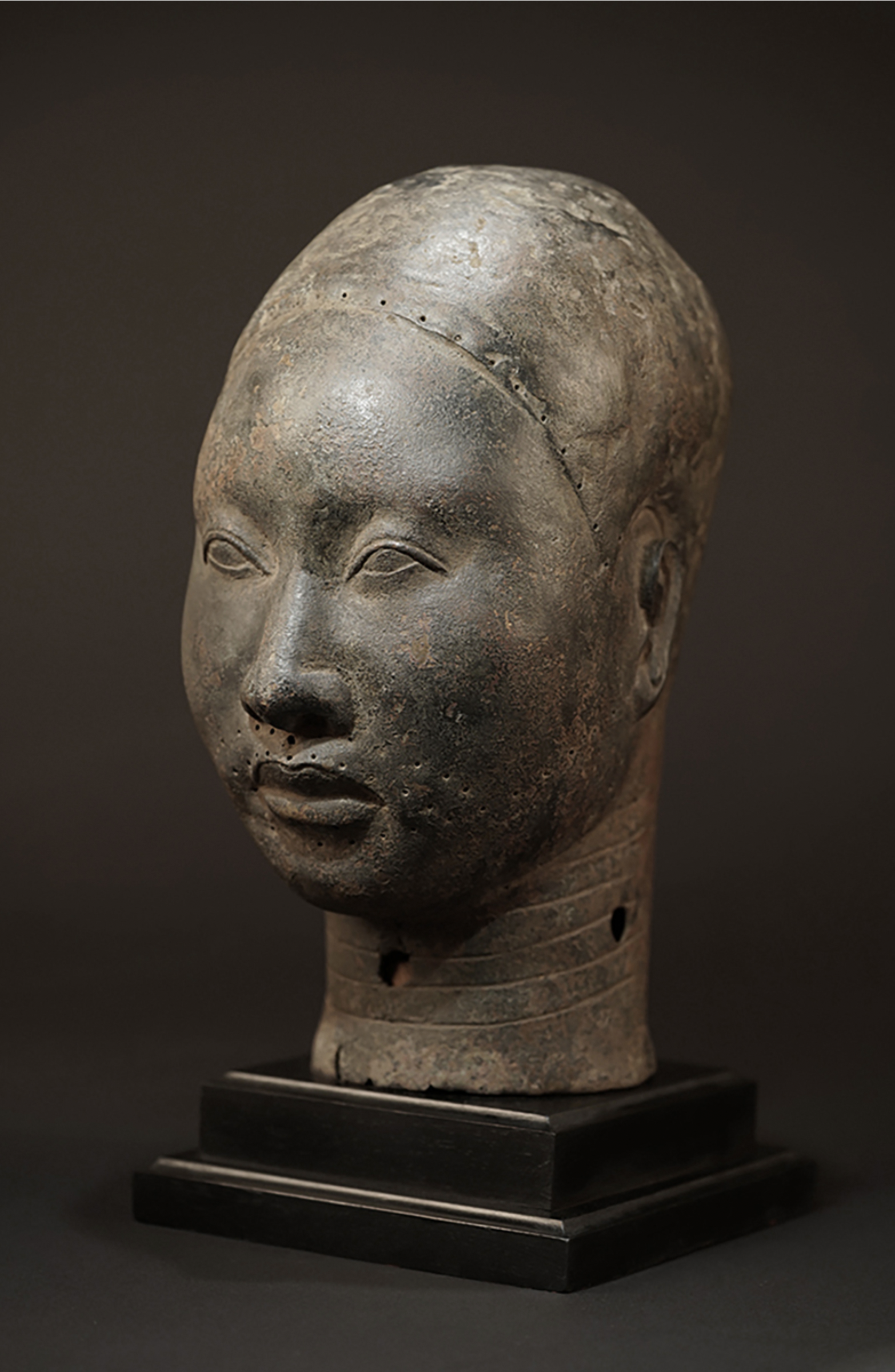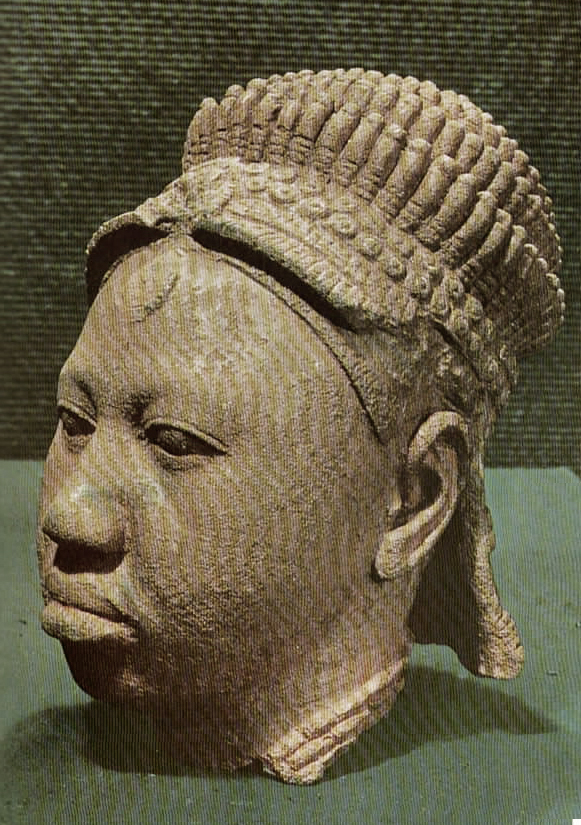wolfgang-jaenicke
A head of Olokun
A head of Olokun
Couldn't load pickup availability
A head of Olokun in the style of Ife, Nigeria, But there are different opinions about this bronze head. Another opinion, based on oral tradition, assumes that this is the portrait of a Queen of the Ooni,, different layers of encrusted oxidations of this copper-rich, reddish bronze shows a long-lasting aging process.
This bronze head exemplifies the naturalistic and highly refined casting tradition of Ife, dated to the 12th–18th centuries CE. The figure displays the characteristic idealized proportions of Ife sculpture, including a serene facial expression, delicately modelled eyes and lips, and intricate attention to surface detail, reflecting mastery in lost-wax bronze casting. Traditionally, the work has been associated with Olokun, the Yoruba deity of the sea, wealth, and spiritual mysteries, aligning with the Ife practice of expressing both divine and political authority through portraiture.

Head of an Ooni exhibited 2018, Wolfgang Jaenicke Gallery.
An alternative reading, grounded in oral tradition, identifies the head as a portrait of a queen of the Ooni. Proponents of this interpretation emphasize the historical role of royal women in Ife society and suggest that certain iconographic markers—such as hairstyle, scarification, and the absence of explicitly divine attributes—indicate human rather than divine representation. This dual attribution illustrates the methodological tension between stylistic analysis and oral-historical testimony, highlighting the interplay of human and divine authority in Yoruba artistic culture.
Comparable works are held in the British Museum (London), the Metropolitan Museum of Art (New York), and the Ife National Museum (Ife, Nigeria), where similar heads provide context for both divine and royal portraiture. Related pieces can also be found in the Wolfgang Jaenicke Gallery collection, reflecting continued interest and scholarly engagement with Ife bronzes, https://www.wolfgang-jaenicke.com
Olókun is an Orisha (deity) of the Yoruba and Edo peoples, associated with the sea, bodies of water, wealth, and hidden knowledge. In certain mythological accounts, Olókun is described as ruling the oceans, bringing prosperity, and appearing in male, female, or sexless/androgynous forms. For example, it is noted that “in West African areas directly adjacent to the coast, Olókun takes a male form … in the hinterland, Olókun is a female deity.” In some sources, Olókun is further identified as “the senior wife of Emperor Oduduwa,” with the explanation that “according to Yoruba traditions … Olókun – in her female incarnation – was the senior wife of Emperor Oduduwa.”
Other texts describe Olókun as “the parent of Yemoja” and in certain sources as the consort of Orunmila, the deity of divination. However, there are traditions in which Olókun is said to have no partner or offspring.
Regarding the question of Olókun as the “wife of an Ooni,” it is important to clarify that the title Ooni traditionally refers to the king of Ile‑Ife (Yoruba). A survey of scholarly and mythological sources does not provide any reliable evidence identifying Olókun as the spouse of a historical Ooni. Rather, Olókun is a mythological deity whose relationships are situated in the cosmic or divine sphere, rather than in historical or royal contexts.
Based on the literature, it can be concluded with high probability that Olókun is not a “wife of an Ooni” in any historical sense. Olókun is a deity with multiple manifestations, sometimes represented as female and/or as the consort of another Orisha (e.g., Orunmila). Given that Olókun may also appear as male or androgynous, the designation “wife of an Ooni” is not substantiated.
Comparable works include the British Museum, London (EA 3305), the Metropolitan Museum of Art, New York (C.I.69.24.2), and the Ife National Museum, Ife (catalogue no. 154). Related pieces are also in the Wolfgang Jaenicke Gallery collection. Many of these prominent bronzes were “restored” during the 1960s and 1970s in a manner that removed their original patina. Nevertheless, these objects are generally old, even if their appearance suggests otherwise. Determining their age cannot reliably be based on stylistic features alone, but must instead rely on scientific methods such as thermoluminescence analysis.

Frank Willett, Ife, plate IX.
Blier, Suzanne Preston. Art and Risk in Ancient Yoruba: Ife History, Power, and Identity, c. 1300. Cambridge: Cambridge University Press, 2015. ISBN 978‑1‑107‑02166‑2. – Untersucht die Herstellung, Ikonographie und politischen Kontexte der Kupfer‑, Bronze‑ und Messingköpfe von Ife. Online-Zugang: wcfia.harvard.edu
Platte, Editha; Hambolu, Musa. Bronze Head from Ife. London: British Museum Press, 2010. ISBN 978‑0‑7141‑2592‑3. – Einführung in den Bronze-Kopf Af1939,34.1 im British Museum, mit Kontext zu Fundgeschichte, Materialtechnik und Rezeption. Online-Zugang: britishmuseumshoponline.org
Mack, John (Hrsg.). Africa: Arts and Cultures. London: 2005. – Enthält einen Aufsatz zur Skulpturtradition von Ife und bietet einen Überblick über historische und kunsthistorische Hintergründe. Online-Zugang: christas.dk
Blier, Suzanne Preston. „Art in Ancient Ife“. In: African Arts, Winter 2012, Vol. 45, No. 4. – Behandelt Gesichtsnarben, Ikonographie und politische Bedeutung, vorwegnehmend die Themen ihres Buches. Online-Zugang: Harvard Scholar.
„Myths, modes of Ife sculptures“. The Nation Newspaper (Nigeria), 10. Januar, Jahr nicht angegeben. – Populärwissenschaftlicher Text über die Möglichkeit königlicher Frauen in den Skulpturen („head of a queen“). Online-Zugang: The Nation Newspaper
British Museum. „Bronze Head from Ife“ (Objektnummer Af1939,34.1). – Sammlungseintrag mit Materialdaten, Provenienz und Sammelgeschichte. Online-Zugang: britishmuseum.org
Height: 29 cm
Weight: 3,1 kg






























